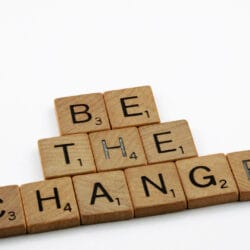We hear about virtue signalling a lot these days, but what exactly does it mean,…
Creativity is often misunderstood as artistry, but it also goes beyond expression and is vital towards problem solving and improvement.
To become an innovative problem solver there’s one key skill we need to encourage and develop, our creativity.
We say skill because creativity CAN be unlocked and enhanced.
Just like training a muscle, once we give it the right tools then we begin to unlock its potential. When we do we unlock the vision that goes into seeking out solutions to problems.
What Type Of Creativity Leads To Innovation And Problem Solving?
If we can be creative we can surely innovate.
The difference between the two terms is that ‘creativity’ itself involves the ability to conceive a new idea, while ‘innovation’ involves turning that idea into a workable solution, one that fits a need or that is marketable.
Creativity is ideation, and only once we ideate can we then implement through innovation.
However, when we think of creativity we often think of it in an artistic sense, but really there are really two kinds of creativity (although many scholars and suggestions have led to sub-types of creativity).
There’s creative artistry and creative ingenuity.
Artistic creativity is what most people would associate with creativity. They think of those creative few in the arts who can write songs, dance, and paint. It’s this notion of creativity that makes people think that they aren’t creative simply because they can’t paint like Van Gogh or Dali, or can’t compose like Mozart or Beethoven.
Yet, we are all creative artistically, it’s just subjective and based more on people’s feelings whether constitutes ‘art’ or not. There’s another form of creativity though that is more objective, our creative ingenuity.
This is the side of creativity that focuses on solving problems and innovating solutions, rather than express one’s artistic ideas. Da Vinci was a genius in both forms. He could paint better than most, but his true genius came through his ability to conjure up inventions and solve problems that had no prior solutions in the world.
Which Type Of Creativity Do We Need More?
Another way to consider the difference is how creativity is important towards progress in different ways in both types: creative ingenuity (innovation) satisfies humanity’s physical progress, whereas artistic creativity satisfies humanity’s emotional progress.
Our life needs both forms of creativity to blossom. They both help our fluid intelligence. A truly satisfied creative would likely want to explore both forms of creativity.
When we push our minds to think beyond the box we find we can come up with perspectives and ideas we didn’t have before. This is true in both forms of creativity, but especially so with creative ingenuity.
When we misunderstand the benefits of creativity in multiple forms we only limit ourselves to think in creative ways that may suit our situation.
For too long businesses have been tentative in allowing creativity to flow in the workplace simply because they misunderstood the context of what creativity really is for them.
They may worry about people floating about the place with paint and lucid ideas that don’t have any logical structure or direction, whilst missing out on the creative ingenuity that would bring out their problem-solving capacity (something every business needs).
It’s not just about business though. Creative ingenuity has a place in our everyday lives too, such as when we need to come up with a solution to help our child be less worried about visiting the dentist, or when we think of a new tactic to win a game.
Artistic creativity has a place in our day too, as when expressing ourselves we are generally more at ease and happier with life. Our interactions are more enhanced when we are creative in finding fun ways to share time together.
However, to innovate and problem-solve, to truly go and push beyond our boundaries, we need to concentrate on our creative ingenuity, and it is this side of creativity that Richly Wills tends to mean when we talk about creativity.
Example Of Creative Ingenuity At Play
We can show creative ingenuity in every part of our lives. It’s not limited to the arts. This is invention, innovation, design thinking, problem-solving. It’s where we come together to solve problems for a wide range of issues in the world.
Brunel was supremely creative in this sense. He was a problem solver in both technical ways of creating tunnels, bridges, and so on, but in also creating a human-centered user experience for the passengers of his trains. He engineered around solving the problem of what passengers would want – a comfortable journey.


Steve Jobs was also very innovative in how we wanted to make technology easy to use (yet Apple also showed their artistic creativity in making them aesthetically pleasing).
Elon Musk is the man-of-the-hour (or decade) who sees problem-solving in his sleep, not because he likes to just have problems to solve but because he has a vision of a world he would like to see for real, whether that was developing a new way to exchange money online or come up with a space rocket that lands itself.
It’s not just famous examples that show our creative endeavor to solve problems. We can find this kind of creativity in all fields of human activity: in science, education, engineering, healthcare, agriculture, finance, transport, housing, climate change, and more.
We can find innovative problem-solving in the smallest of things, such as how we developed coasters to stop drinks from spilling on tables, shelves to store books, and keypads to open doors.
It’s not just about products or services either. It can be innovative ways to gain an edge or make life better. It can be coming up with trainers with springs in them to make you walk faster, or seek a creative way to organize your desk so that it helps you flow better.
It doesn’t have to be groundbreaking, but often innovation comes through seeking to improve on what is already there. If you take a look around you will find an innovative solution somewhere close by.
The person who invented the cats-eyes you see on the roads at night had a creative solution to a problem. They were creative in coming up with something that didn’t exist before, yet innovative with that creativity in ensuring that they were creating something that would fulfill a need.
We Create Want We Want, We Innovate What We Need
It’s the vision that drives creativity. Seeing a solution to a problem.
Creative ingenuity is often heightened in times of need, such as when a recession or pandemic hits. It’s an instant wake-up call for innovative solutions to flow. Indeed some of the most creative solutions in human endeavor have come about because of a crisis.
Throughout history creative ingenuity has often been heightened, but not just when hard times hit, but because we are hard-wired to survive, and part of achieving this is to seek to thrive and develop our humanity further.
For a long time, we were satisfied with simply innovating an improvement to something, to make our life easier (as we had a lot to innovate and engineer towards a better standard of living), but as humanity has reached such comfortable heights in comparison to the relatively basic innovations just 100 years ago (thanks to technology speeding up innovation around the world tenfold), we now have to think harder about needs rather than mere wants.
Solving problems is as much about putting things right today, as it is about conjuring up improvements. While we work on envisioning the next big thing (clearly AI advancement), we also need to consider the implications of such innovations, such as how climate change could be affected (or even our own human lives with AI advancement).
We’ve had a century of constant growth with little ethical thought, so innovation moves to a more understanding and compassionate level for our world, and for each other. We have to tackle social innovation issues such as globalization and the resulting diversity it brings – something which is wonderful if we embrace it, but also leads to a lot of pre-conditioned bias and conflict of interests amongst people.
We don’t just think of designing a game to make it addictive, to add dopamine kicks or screen time. Instead, we consider how this game can add to that person’s life. The days of simply getting someone hooked for profit are going to be behind us soon enough, and instead, it will be about how what we produce (and buy) adds value to ourselves and our world.
These are now the ‘wicked problems’ we face through ethical design thinking, and our creative ingenuity, our innovative mindset will help us solve them together through co-creation.
We need to conceive ideas that are potentially tangible solutions that fit real-world needs, such as developing an app that provides opportunities to those who don’t currently have them, seeking ways to ensure people live more balanced lives, and so on.
Yet, with every solution comes another problem to solve, so creativity ingenuity isn’t about merely coming up with a pie-in-the-sky idea such as saying there will be flying cars in the future, but from seeing out all the smaller problems that mount up to make that possible, and the other problems creating that solution will then create.
Creative ingenuity is a constant process of iteration (refinement), and this is why it follows the 4! (sounds like ‘fry’) design thinking process of inspiration, ideation, implementation, and iteration.









